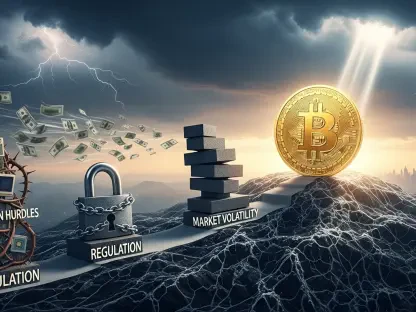In the ever-evolving realm of digital finance, the advent of stablecoins has presented new dynamics and opportunities for cryptocurrencies like XRP to showcase their unique strengths. While stablecoins such as RLUSD gain traction for their fiat-backed stability, XRP plays a critical role in cross-border payments, owing to its core characteristics that support efficient global transactions. The intersection of XRP’s capabilities with the increasing popularity of stablecoins raises intriguing questions about the future landscape of digital money. This article delves into the complementary roles of XRP and stablecoins within Ripple’s ecosystem and outlines XRP’s strategic significance in the global financial infrastructure.
XRP’s Functionality in Cross-Border Transactions
Bridging Currency Across Global Markets
XRP’s essential role as a bridge currency is prominently highlighted within the vast landscape of cross-border financial exchanges. Its primary function lies in its ability to facilitate rapidly settled transactions and efficiently convert varied currencies without the necessity of holding them for long durations. In a period marked by fragmented monetary systems and the need for immediate transaction settlements, XRP stands out by decreasing conversion friction, making it a favorable choice for international financial exchanges. This unique aspect of XRP ensures transactions are quick and seamless, reducing costs associated with currency conversion and settlement time, which is crucial for both businesses and financial institutions.
The stability and reliability of XRP become even more apparent when considering how it minimizes risk tied to exchange rate volatility. By holding XRP only briefly during transactions, it circumvents prolonged exposure to market volatility, a significant advantage over other currencies that might be more susceptible to fluctuations. This operational mechanism is particularly appealing to financial service providers that prioritize transaction efficiency and reliability. Meanwhile, liquidity providers investing in XRP ensure a steady demand, amplifying its enduring relevance in global payment ecosystems. XRP’s efficacy in providing a stable bridge between diverse currencies helps uphold its position as a pivotal component of international financial operations.
Addressing Volatility and Demand Concerns
Despite concerns over its volatility, XRP’s strategic role offers mechanisms to mitigate potential risks associated with price fluctuations. In cross-border transactions, XRP’s transient presence significantly lessens exposure to market volatility, acting as a safeguard against the unpredictable nature of price changes in digital asset trading. This makes XRP an attractive option for enterprises that require certainty and stability in the settlement process. Its short-term integration into transaction cycles is a calculated move that strategically balances volatility risks while leveraging its liquidity advantages.
Liquidity providers, tasked with holding reserves of XRP, play a crucial role in maintaining its demand across financial networks. Their participation catalyzes an ever-present need for XRP, reinforcing its indispensability in facilitating seamless global transactions. The dual approach of minimizing volatility impacts and securing continuous demand illustrates XRP’s resilience and adaptability. By effectively addressing concerns associated with volatility, XRP accrues considerable trust and reliance from institutions engaged in digital finance. Its role as a stable intermediary continues to solidify as organizations factor in these advantages in their operational frameworks.
The Rising Influence of Stablecoins
RLUSD’s Integration within the Ripple Ecosystem
Stablecoins have emerged as valuable tools within the cryptocurrency space, bolstered by their ability to mitigate volatility due to being tethered to fiat currencies. RLUSD epitomizes the shift towards stablecoins providing assurances of value preservation, particularly in industries reliant on stable transaction mediums. Ripple’s strategic evolution showcases a harmonious integration of RLUSD, enhancing the broader ecosystem while distinguishing its complementary role from XRP. The individual attributes of RLUSD enrich Ripple’s offerings, as stablecoins often play roles better suited for localized value management rather than cross-border transactions.
Instead of creating competitive friction, RLUSD and XRP coexist to serve distinct needs within the financial ecosystem. While RLUSD provides stability and predictability in value shifts, XRP’s neutrality as a digital asset empowers its capability as a universal bridge currency. This synergy allows Ripple to offer comprehensive solutions that cater to both regional stability requirements and expansive international transaction demands. The complementary nature of stablecoins like RLUSD fortifies Ripple’s ecosystem, enhancing the robustness and versatility of its financial tools.
Ripple’s Strategic Approach to Stablecoin Collaboration
Ripple’s foresight to integrate stablecoins alongside XRP highlights a proactive commitment to evolving the digital currency landscape by harnessing diverse monetary capabilities. The strategic collaboration underscores Ripple’s ambition to marry the security and predictability of stablecoins with the dynamic, adaptable properties of XRP. By avoiding the perception of competition, Ripple nurtures an environment where these assets collectively extend strong, diversified offerings to users globally. The strategic fusion of stablecoin assurances with XRP’s transactional efficiency epitomizes Ripple’s commitment to a versatile financial ecosystem.
Extending beyond mere coexistence, Ripple’s approach encourages broader adoption of its digital financial products, appealing to a wide spectrum of institutional partners seeking assurance and efficiency. The deliberate focus on supervised domains provides Ripple with the means to curb misuse risks while promoting the secure adoption of its offerings. This holistic strategy invites institutions to embrace Ripple’s blend of stablecoins and XRP, securing its role as a frontrunner in advancing global payment systems. Ripple’s strategic vision remains rooted in enhancing, not replacing, the multifaceted landscape of digital currency through careful integration and collaboration.
Concluding Perspectives on XRP’s Position in Digital Finance
In the rapidly changing world of digital finance, stablecoins have introduced fresh dynamics and opportunities for cryptocurrencies like XRP to showcase their distinct advantages. Stablecoins gain attention for their ability to provide fiat-backed stability, appealing to those looking for less volatile digital assets. However, XRP continues to play a pivotal role in the realm of cross-border payments due to its design, which promotes swift and cost-effective global financial transactions. The convergence of XRP’s capabilities with the growing popularity of stablecoins sparks interesting discussions about the future of digital currencies. This discussion explores the complementary functions of XRP and stablecoins within Ripple’s framework and highlights XRP’s strategic importance in the international financial system. Understanding how these digital assets coexist and support one another offers valuable insights into how the future of digital money might unfold, shaping financial interactions on a global scale.









